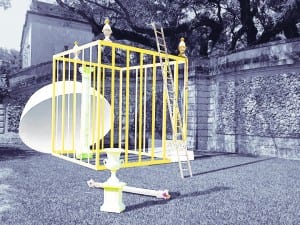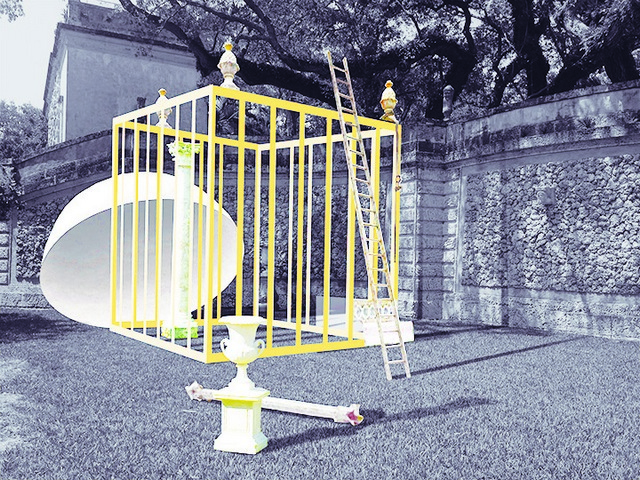
Vizcaya Museum and Gardens recently announced the scheduling of “Lost Spaces and Stories of Vizcaya,” a two-part exhibition on view, from May 2016 through May 2017, in conjunction with Vizcaya’s centennial.
Lost Spaces will feature original installations by 11 contemporary South Florida artists or collaborative teams commissioned through Vizcaya’s Contemporary Arts Program (CAP). The installations all comment on historical elements of the estate, whether physical or narrative, that have been lost to time.
The artists selected to present their work are Duane Brant, Brookhart Jonquil, Amanda Keeley, Juraj Kojs, Mira Lehr and Yara Travieso, Lucinda Linderman, Kerry Phillips, Leyden Rodriguez-Casanova, David Rohn, Magnus Sigurdarson and Frances Trombly.
The inspiration for the exhibition is closely tied to Vizcaya’s history. Vizcaya’s owner, James Deering, and his designers created a fantastical place, one that was evocative of Europe yet distinctly rooted in its Miami setting — and one that incorporated commissioned work by multiple contemporary artists.
While we know a good deal about the estate’s history, there is also much that is unknown. During the past century, man, nature and time have transformed Vizcaya. Ranging from the destruction of a fanciful swing by a hurricane to the absence of staff that once populated the estate, many of Vizcaya’s compelling spaces and stories have disappeared.
Lost Spaces will showcase installations in and around the Main House and gardens that aim to bring these lost spaces and stories “back to life.”
“We’ve commissioned local artists who have a unique perspective on Vizcaya’s place in Miami’s cultural landscape to bring back lost elements of the estate’s original design,” said Gina Wouters, curator of Vizcaya Museum and Gardens. “Through the Lost Spaces project we truly integrate our Contemporary Arts Program within the aesthetic and interpretive framework of the historic site.
“The installations will be unveiled in two phases beginning in May 2016, infusing the site with momentum and awareness that will help set the stage for our centennial.”
Phase I of Lost Spaces will be on view from May 2016 through May 2017. Phase II will be displayed from December 2016 through May 2017.
The work of the artists featured in Phase I relate to the themes of Vizcaya’s Moat, Map Racks, Staff Life and Lost Decorated Rooms. Juraj Kojs will create a soundscape of the historic Moat that runs below Vizcaya’s ticket booth, filling it with ambient sound. Also in the Moat, Duane Brant will establish a minimal “white stripe” to indicate the extent of the space.
Lucinda Linderman will fabricate a series of soft felted sculpted maps depicting South Florida in the 1920s, now and 50 years from now, thus referencing the original function of the now-empty Map Racks in the Main House. David Rohn will create portraits of former staff, placing them in the spaces they would have served. Frances Trombly will design pulls for the historic bell pulls that summoned staff throughout the Main House.
Amanda Keeley’s installation will feature a neon sign translating the Latin quote on the east façade of the Main House, “Accept the gift of pleasure when it is given. Put serious things aside.” Magnus Sigurdarson will film a telenovela in the Enclosed Loggia and East Loggia, two spaces whose furnishings are no longer on display. Sigurdarson’s narrative will incorporate references to the ways in which the spaces were once used by Vizcaya’s occupants.
During Phase II, from December 2016 through May 2017, artists will create works in four areas related to Vizcaya’s gardens and leisure spaces: the Casba, South Property, the Casino and Basement Recreational Rooms. These locations highlight elements of the original design intent that no longer exist.
The Casba is a small, exotic pavilion that was originally part of Vizcaya’s southern gardens and is now on the grounds of the Archdiocese of Miami. Leyden Rodriguez-Casanova’s piece will create a reference to the Casba that appears as either unfinished or deconstructed, depending on the viewer’s perspective.
Mira Lehr and Yara Travieso’s installation will personify Vizcaya as Queen Dido, the first queen of Carthage according to ancient Greek and Roman writers. Their work will be activated through performances, and evoke the exotic wildlife that once existed on the South Property.
Kerry Phillips will create an installation for the winding white marble staircase in the Shop and Café area that once served as quick access for Deering and his guests from the East Loggia to the recreational rooms. The project will consist of found furniture installed with a sense of movement suggesting that the pieces are rushing down the stairs.
Brookhart Jonquil is developing a piece for the two rooms in the Casino, or small house, on the Garden Mound. This piece will focus on the original fixtures in the rooms, while using architecture and light as a bridge between the physical and immaterial. His work will also speculatively reference the daily activities that might have taken place in those spaces.
Lost Spaces and Stories of Vizcaya imaginatively investigates the estate’s unknowable past through the work of singular local artists. For more information visit www.vizcaya.org or call 305-250-9188.
Vizcaya Museum and Gardens is a National Historic Landmark that preserves the Miami estate of agricultural industrialist James Deering to engage our community and its visitors in learning through the arts, history and the environment. Built between 1914 and 1922, Vizcaya is one of the most intact remaining examples from this era in United States history, when the nation’s most successful entrepreneurs built lavish estates inspired by the stately homes of Europe.
Vizcaya features a Main House, 10 acres of formal gardens, a rockland hammock (native forest), mangrove shore, the Vizcaya Café and Shop presented by A Joy Wallace Catering, Design and Special Events, and a historic village that will be restored for additional venues for programs and community outreach.
Located at 3251 South Miami Avenue, between Brickell Avenue and Coconut Grove, Vizcaya is open daily from 9:30 a.m. to 4:30 p.m. except Tuesdays, Thanksgiving Day and Christmas Day.
For more information, visit www.vizcaya.org or call 305-250-9133.






